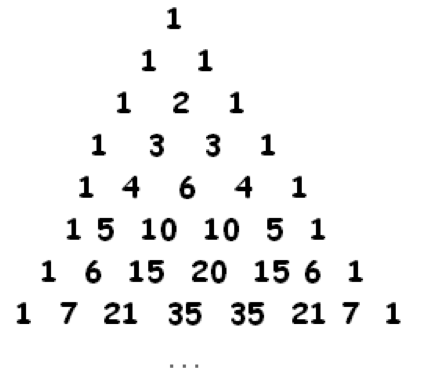Permutations and Combinations
3.4 More Patterns
Lesson materials located below the video overview.

| Exercise 33: Notice:
\(1 = 1\) \(1 + 1 = 2\) \(1 + 2 + 1 = 4\) \(1 + 3 + 3 + 1 = 8\) \(1 + 4 + 6 + 4 + 1 = 16\) a) Without doing the computation, explain why the sum of entries in any row shown above will turn out to be double the sum of the entries in the row just above it. HINT: Each entry in any one row is the sum of two entries in the row above it.
b) Explain why the sum of entries in the \(n\)th row is sure to be \(2^{n}\). (Remember to call the top row of Pascal’s triangle the zero-th row.) |
| Exercise 34: Explain why each alternating sum in Pascal’s triangle, beyond the zero-th row, is zero:
\(1 – 1 = 0\) \(1 – 2 + 1 = 0\) \(1 – 3 + 3 – 1 = 0\) \(1 – 4 + 6 – 4 + 1 = 0\) \(1 – 5 + 10 – 10 + 5 – 1 = 0\) |
The following property is strange. Look at the powers of \(11\):
\(11^{0} = 1\)
\(11^{1} = 11 \)
\(11^{2} = 121 \)
\(11^{3} = 1331 \)
\(11^{4} = 14641\)
\(11^{5} = 161051 = 1|5|10|10|5|1\) (See Exploding Dots!)
Any guesses as to why these powers appear as rows of Pascal’s triangle?
Resources
Books
Take your understanding to the next level with easy to understand books by James Tanton.
BROWSE BOOKS![]()
Guides & Solutions
Dive deeper into key topics through detailed, easy to follow guides and solution sets.
BROWSE GUIDES![]()
Donations
Consider supporting G'Day Math! with a donation, of any amount.
Your support is so much appreciated and enables the continued creation of great course content. Thanks!
Ready to Help?
Donations can be made via PayPal and major credit cards. A PayPal account is not required. Many thanks!
DONATE![]()


